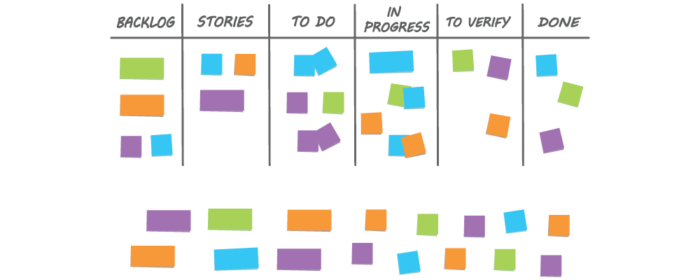You must have heard of sprint planning in Scrum, but can you do the same using Kanban methodology? Yes, you most definitely can. We have dedicated this post to Kanban sprint planning, what it entails and how you can do it.
Before we walk you through the ABC of sprint planning in Kanban, let us take understand the basics of sprint planning.
What Is Sprint Planning?
Sprint planning is a part of Scrum methodology wherein projects are divided into smaller deliverables and each task is prescribed a specific time period for completion. The division of the project into time-constrained tasks in a team is called a Sprint.
Sprint planning or simply planning a sprint refers to an event in Scrum wherein teams determine the amount of work to be done in terms of the product backlog items, within a specified time period. Sprint planning usually involves all the members of a Scrum team. A Scrum team has three definite roles for all the individuals in a team i.e., Scrum master, product owner, and developers.
The scrum team identifies all the stories to be completed, sets goals for each sprint, and plans each and every step to make sure the process runs smoothly.
Scrum board is also a part of this methodology that displays a big picture of the workflow highlighting all the stories or tasks to be completed. The stories move from the backlog, to work in progress (WIP) and finally completion.
What Is Kanban Methodology?
Much like Scrum, Kanban methodology relied on the division of complex projects into smaller ones. Kanban uses Kanban boards for visualization of the workflow.
The only point of difference between Sprints in Scrum and Kanban boards is that Scrum aims to limit the time required for the accomplishment of a task. Kanban, on the other hand, limits the amount of work to be done in WIP.
Why Integrate Sprint Planning with Kanban?

It is often mistakenly perceived that Scrum and Kanban are poles apart. While it is true that both the methodologies function on different principles, there are several points of intersection. So, instead of choosing between the two, integrating sprint planning with Kanban methodology can transform the way you organize and manage your workflows.
Scrum and Kanban are geared towards the continual improvement of work processes and lay importance on the optimization of performance for better results.
Another similarity that binds Scrum and Kanban is the visualization of work in progress that makes sure that all the members are on the same page and making progress along the way. In addition, both management methodologies break down complex projects into smaller, readily accomplishable tasks.
The similarities between both the management systems indicate that integrating Kanban and Scrum can prove beneficial for the team as well as the organization as a whole.
Kanban sprint planning tells teams about the capacity for more work to be added during a sprint. If a work item is not finished in a sprint, teams can carry it over to the next sprint and work on it.
This method can assist teams in identifying gaps and correcting the process.
Sprint planning using Kanban might be a game changer for Scrum teams. According to industry observers, teams working on mature products are more likely to use this method.
This is because the complexity of these commodities has decreased, and the teams working on them have a better grasp of the kind of items they would work on. This puts less attention on introducing features and more emphasis on stability and improved workflow.
Kanban Sprint Planning or Flow-Based Sprint Planning:

Flow-based sprint planning is another name for Kanban sprint planning. Kanban Guide for Scrum Teams defines spring planning in Kanban as a meeting in which flow metrics are used to develop forecasts for Sprints. Scrum teams use Kanban metrics to determine their goals for the next sprint.
The flow metrics reflect the health and performance of a team. The metrics in question include:
- WIP or Work in Progress: The number of work items in progress.
- Cycle Time: The elapsed time between the ‘start’ of a work item and the “finish”.
- Work Item Age: The difference in time between the ‘start’ of a work item and the current time.
- Throughput: The number of work items completed in the given time.
To keep track of cycle time and work item age, Scrum teams have to keep track of the start and finish date of each task or work item. The monitoring of these metrics helps teams identify the loopholes in their performance so that they can improve their work progress in the future.
Integrating Kanban with Sprint planning does not, however, affect the way work is done. In fact, it only brings more clarity to the workflow and makes teams more efficient and productive.
Kanban sprint planning helps teams know whether there is a capacity for more work to be added during a sprint. If a work item wasn’t completed in a sprint, teams can move it to the next sprint and continue working on it.
This technique can help teams identify the gaps and course-correct the process. It ultimately leads to an increased improvement in the workflow and optimization of work processes.
How To Do Sprint Planning with Kanban?
Teams employing the use of Kanban methodology during sprint planning essentially limit the number of tasks or work items in the workflow. The teams have to keep an eye on the ‘start’ and ‘finish’ time of work items in progress.
To control the number of work items, the Kanban board uses WIP limits indicating the number of work items to be added in a single column. The ‘pull system’ created thus, makes it easy for the team to determine when they need to start adding items in the WIP column or when can they start working on new items.
In such a way, a sprint controls the number of tasks that can be completed in a specific time period. The adaptation of the Kanban methodology in sprint planning improves the focus of the team members and enhances communication and collaboration among the team members.
How to Use Scrum and Kanban Together?
Scrumban is an agile management method that combines Scrum and Kanban. As a result, the name is a combination as well. We may conceive of it as a cross between the two, combining the best of both. Scrumban was created to let existing Scrum teams easily move to Kanban and experiment with a leaner approach.
It combines Scrum design with Kanban workflow and visualization. Giving teams the agility of Scrum with the simplicity of Kanban while requiring no roles and making the new process simple to implement.
FAQ’s
Does Kanban have planning?
Kanban planning, especially inside a digital Kanban application, can help everyone grasp what has to be done and when. You can gather as a group around a whiteboard to debate which things must be accomplished, in what order, and by whom, and then get to work.
How long is a sprint in Kanban?
A sprint can be of any length, although the most common are two-week and 30-day sprints.
Scrum teams have specified processes, roles, rituals, and artifacts. Sprints are set periods of time during which a body of work must be completed before the following Sprint may begin.
Can Kanban have sprints?
Kanban does not include or need sprints. The framework utilizes a range of methodologies and technologies, such as the Kanban board, to address the benefits of the Scrum sprint.
Conclusion:
Flow-based sprint planning or sprint planning with Kanban is a hybrid technique that employs the use of features from both methodologies. While the technique has proved its benefits for teams, it might not be suitable for every team.
Consider all the options before making a decision. It has been noted that this technique is more suitable for teams working on mature products. This is due to the fact that these teams have more or less grasped the complexity of work items and now their focus is not on building new features but on gaining and maintaining long-term stability.
With all the information at hand, we hope you can make a wise decision for your team.
Best of luck!

